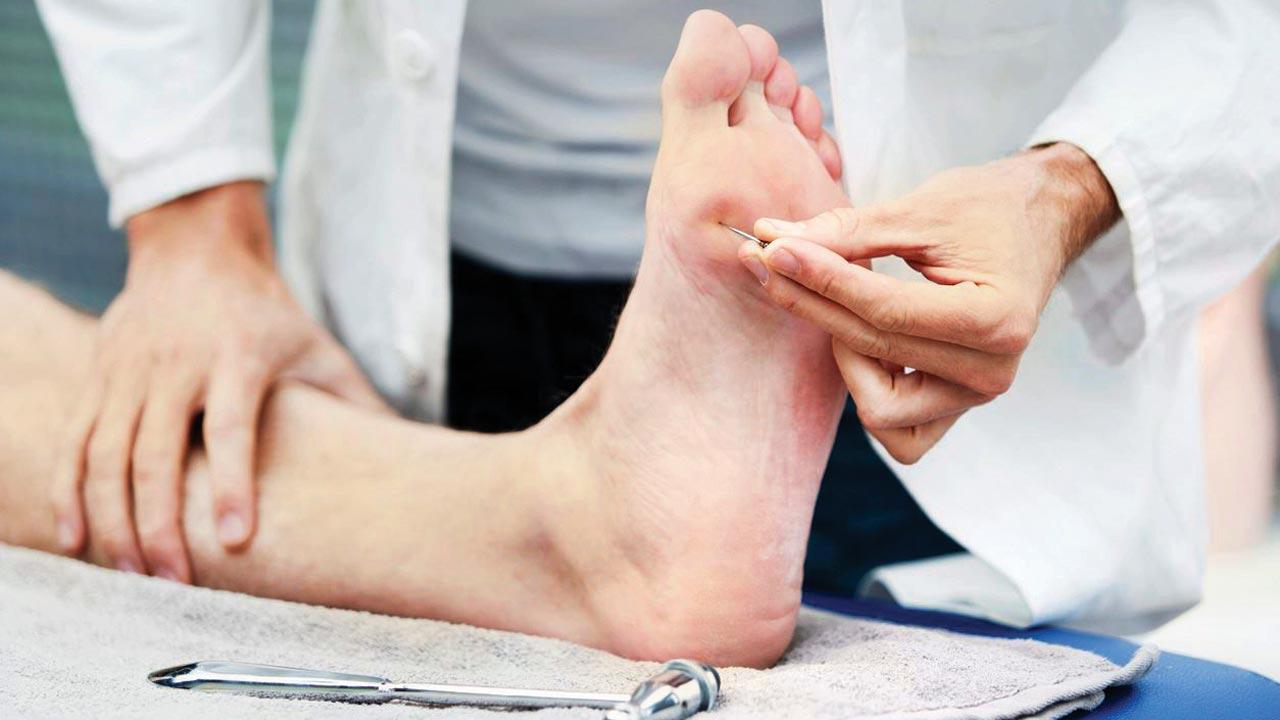Amid sharp rise in Type 2 diabetes in WFH professionals, experts say people shouldn’t ignore minor cuts, tingling sensation in feet as it may lead to gangrene, amputation if unmonitored

Changes in skin colour and temperature, swelling in foot or ankle, pain in the legs and open sores on foot that are slow to heal are some of the symptoms of diabetic foot
Growing cases of Type 2 diabetes, which can cause diabetic foot, in working professionals is a fallout of the pandemic, says a study by Johns Hopkins School of Medicine. If left unmonitored, the condition raises the risk of gangrene and amputation, say experts. In a diabetic foot, a person loses the sensation in the body part, thus failing to notice cuts and blisters. The seemingly minor wounds trigger bigger problems.
ADVERTISEMENT
Dr Wiqar Shaikh, Professor of Medicine, Grant Medical College and Sir JJ Group of Hospitals, said a study published in the International Journal of Clinical Practice, UK, had found a substantial rise in Type 2 diabetes during the COVID outbreak. Another study done in Kolkata, published in the Diabetes and Metabolic Syndrome, pointed to a similar situation in India.
Quoting the findings by the Johns Hopkins School of Medicine, he said a sedentary lifestyle raises chances of high blood pressure, diabetes, heart attacks, cancers and falls. “A study from Italy published in Practice Update pointed to a three-fold increase in the incidence of diabetic foot and resultant amputations during the pandemic. A study published in the Sports Med and Health Sciences in May 2020 also had concluded similar risks,” he said.
“Diabetes mellitus is assuming epidemic proportions in our country. More and more younger individuals are being diagnosed as diabetic. Diabetes over a period of time typically affects both the nerves and blood vessels, thereby making feet vulnerable to injury and infection. Diabetic foot is one of the most dreaded and morbid sequels. Untreated or improperly managed, it can lead to spreading life-threatening infections requiring major amputations of the lower limb,” said Dr Ketan Vagholkar, Professor of Surgery at DY Patil Medical College.
A diabetic should regularly visit a surgeon to check the extent of both vascular and nerve involvement. “Strict control of blood sugar, properly formulated diet and exercise will help control blood sugar levels. This should be followed by specific dos and don’ts to prevent foot infection. Minor injuries and infections of the feet need to be treated by a specialist surgeon at the earliest. Rigorous control of blood sugar levels along with a periodic assessment of footwear and the use of specialised protective footwear tailormade for diabetics can help prevent the development of foot lesions,” explained Dr Vagholkar.
Expert’s advice
Dr Chandrakant Rao, a diabetologist who has done extensive research on the disease, said, “Diabetic damage to nerves, especially of the feet, is very common but often missed. Hence it is called the ‘Cinderella of diabetes complications’, because neither the patient nor the doctor notices it at early stages, in a busy OPD practice. Patients may experience burning/ pricking sensation, numbness/ tingling or a total loss of sensation. Arterial blocks lead to calf pain on walking,” Dr Rao said.
Diabetics who smoke and have high BP and high cholesterol are at great risk, he said. “About 85 per cent of neuropathy patients can prevent an ulcer, and for those who develop ulcers, 85 per cent can prevent an amputation with proper management. The three most important aspects of preventing foot problems in diabetes are good glucose control [HbA1c <7 per cent], daily foot care and protective footwear,” Dr Rao explained.
‘He had total loss of sensation in his feet’
. A farmer from Pune was suffering from a non-healing diabetic foot ulcer for two years. “As he had a total loss of sensation in his feet, he would walk without footwear. We devised low-cost offloading footwear along with diabetes control which led to complete healing of his ulcer,” said Dr Rao.
. A diabetic, who was also a chronic smoker, used to have pain in his calf on walking which reduced at rest. He had a small cut over his great toe which did not heal for a week. “On the seventh day, he noticed the toe had darkened. There was no pulse in his foot and there was impending gangrene. Tests revealed a blockage in the artery. Urgent stenting and blood thinners prevented amputation,” said Dr Rao.
Foot care
. Look for swelling, redness, cuts
. Avoid barefoot walking, hot fomentation, rigorous massages, tight shoes, cutting nails too deeply (filing nails is safer)
. Diabetics should wear specially designed footwear with MCR-based insoles.
This can prevent ulcers in over 95% patients, said Dr Rao
 Subscribe today by clicking the link and stay updated with the latest news!" Click here!
Subscribe today by clicking the link and stay updated with the latest news!" Click here!







